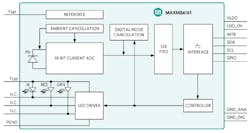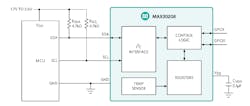Download this article in PDF format.
Maxim Integrated Products has been at the forefront of medical sensing with development kits like the Health Sensor Platform (HSP). The HSP is a modular smartwatch form factor that can monitor a user’s electrocardiogram (ECG), heart rate, and body temperature.
Its latest products, aimed at the wireless earbud market and similar application areas, are the MAX86161 in-ear heart-rate monitor and its MAX30208 digital temperature sensor. They’re designed to deliver clinical-grade medical results while shrinking size and power requirements that are key to delivering compact mobile devices.
The MAX86161 in-ear heart rate monitor (Fig. 1) delivers best-in-class signal-to-noise ratio (SNR) for continuous heart-rate and oxygen-saturation (SpO2) measurements. It incorporates three programmable, high-current LED drivers, yet only requires a single voltage source from 3.0 to 5.5 V. The receiver uses a high-efficiency PIN photodiode with an optical readout channel. This channel has a low-noise signal conditioning analog front-end (AFE) that consists of a 19-bit ADC, and an ambient-light-cancellation (ALC) circuit to support a picket-fence detect-and-replace algorithm.
1. The MAX86161 in-ear heart rate monitor features optics that are 40% smaller than previous versions.
Maxim’s matching optical solution is 40% smaller than previous versions. The chip comes in a 2.9- × 4.3- × 1.4-mm, 14-pin OLGA package. Maxim also provides algorithms for motion compensation to increase measurement accuracy.
The very low power MAX30208 digital temperature sensor (Fig. 2) has an accuracy of ±0.1°C from 30 to 50°C and ±0.15°C over a wider range from 0 to 70°C. The system, replete with 16-bit resolution, uses a single supply voltage from 1.7 to 3.6 V. The tiny 2- × 2- × 0.75-mm, 10-pin thin LGA chip also incorporates a unique ROM ID that allows the device to be NIST traceable.
2. The MAX30208 digital temperature sensor’s accuracy is ±0.1°C.




